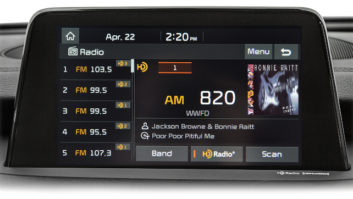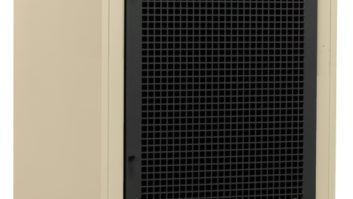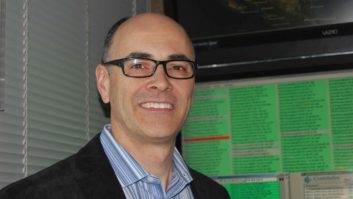The Future is now at Clear Channel Cincinnati
Aug 1, 2004 12:00 PM, By Allen J. Singer
After spending 15 years high atop Frog’s Mountain, Clear Channel has successfully moved its four AM and two FM stations plus five radio networks out of Mount Adams in Cincinnati. This quaint hilltop suburb filled with Victorian houses, gaslights and narrow, hilly streets hosted the old Clear Channel studios in three cramped floors in an office building that had long since been outgrown. This summer the rock jocks, talk show hosts, production crew and salespeople stepped into their shiny new high-tech facility in the nearby suburb of Kenwood, and at the end of July, two more stations located in another part of town joined them. Now that the feat is complete, 250 personnel, including 75 on-air and engineering staff, will all create the magic of radio on one floor under just one roof.

Clear Channel Cincinnati was required to be out of its old building by June 30, or else the company would have had to pay a penalty of $1 million to the landlords. Given the recent severity of the fines, they were well-advised to move their 26 studios by the deadline, because Clear Channel corporate would not have reacted favorably to paying this penalty. After searching Cincinnati for suitable space, local and corporate management chose a building in Kenwood. This location was centrally located and offered the required square footage; although nearly any building around town would have been better than the one previously occupied for a decade and a half.
The WLW talk studio, with a detail on the host position (bottom).
All the control rooms have layouts similar to the WEBN control room.
Some studios, like the WOFX control room, have Airwave consoles that will be replaced by RMXdigital consoles.
The news editing stations are built around a Harris VSDM with access to the Prophet Nexgen and Wire Ready systems.
The cable trough runs down the hall, so neat cable installation was important.
One of many rows of racks that support the new facility.
The WCKY talk studio provides ample room for guests, and the full windows keep the room bright and open.
The terminal blocks on the wall.
Fifteen years ago, the Jacor-owned WLW-AM and WEBN-FM were located on one floor in a Mount Adams office building on St. Gregory St. Over the years, more stations were bought and sold, Clear Channel bought Jacor, one floor became two, two floors became three, and by 2004 the three floors held six radio stations and five networks. The company had also bought two more stations that were located across town at a Clear Channel television facility. Consolidation for all eight stations was an overdue necessity, and it wasn’t going to happen in Mount Adams.
Mount Adams is a tightly arranged, upscale, historic district situated on top of one of Cincinnati’s seven hills. Narrow steep streets wind up and down rows of century-old homes, buildings, bars and shops. Available on-street parking is a rarity, and only a few parking garages serve the area. It was here that WEBN radio staff called their home Frog’s Mountain (Frog being the station’s mascot), and by 2004 their building housed 11 broadcast entities: WEBN-FM, WOFX-FM, WLW-AM, WSAI-AM, WCKY-AM and WKRC-AM, as well as the Bengals Radio Network, the Reds Radio Network, the Truckin’ Bozo Network, the Burbank Broadcast Network and the WKRC Weekend Network. WVMX-FM and WKFS-FM were located in Clear Channel’s Channel 12 building in Mount Auburn.
The old facility occupied 28,000 square feet, with 26 studios spread across the three floors. New studios were built as each station was added over the years, and in the end the staff had to contend with tangled mazes of wiring and outdated analog equipment mixed with modern digital equipment and computer networks. This entire mess was crammed inside an outdated building in desperate need of repair. The overcrowded Clear Channel staff yearned for a change.
Location, location, location
Kenwood is a sprawling upscale suburb on flat ground, conveniently located off I-71. The staff finds it much easier to get to work now, and will no longer need to drive four-wheel-drive SUVs uphill during the winter months. The location also offers plentiful parking, no steep hills, an abundance of restaurants for everyone’s tastes and loads of office space. By the way, did I mention that there are no steep hills?
After Clear Channel chose the Kenwood office building and signed on the dotted line, it hired the Luckett and Farley Architects of Louisville, KY. This firm’s daunting task was to plan how to efficiently fit 41 studios and offices into 50,000 square feet of space on the entire sixth floor. Duke Construction was brought in next, and spent four and a half months in demolition and construction of the new facility. Finally, to put the jewel into the crown of Clear Channel, Harris came in and spent two and a half months in systems integration.
Harris’ team of five cabinet fabricators and four wiring techs built studio cabinetry and equipment racks, pre-wiring nearly everything at the Harris shop. A team of three installers arrived to put in the racks and equipment, and run the wires down hallways into the rooms. As a result of their careful planning and detailed work, the installation went smoothly and no unexpected problems occurred during the build-out. In the end, each station went live without a hitch. Clear Channel was more than pleased with all of Harris’s hard work, especially since the whole project came in on budget.
Inside the facility
Technical operations occupies 25,000 square feet, and an additional 25,000 square feet is on the administrative/office side. The studios are arranged in a U pattern with the main equipment room located in the middle. The terminal room holds 52 equipment racks, structured entirely around the Harris Vistamax Audio Management System, a futuristic routing device designed like a computer network. There are 24 audio consoles and four VSDMs (Very Small Digital Mixers) in the facility that are networked through the Vistamax. This machine binds logic to audio over a single CAT-5 cable, and allows all sources to be available to all consoles over a single line. This is a system Harris has adopted for all of its installations.
Outputs and inputs of every piece of equipment are terminated in the rack to a CAT-5 punch block. Coming out of each rack is at least one 25-pair CAT-5 multi-line laid into overhead wire racks, and terminating to a series of punch blocks on the back wall. All cross-connects for the equipment are done at the punch block wall. Unshielded CAT-5 was used, so ground loops were avoided.
Designers called for wire trays in the facility for several reasons. The costs were much higher to install computer floor, there were other offices in the lower levels, the building featured high ceilings and installers needed easy access to run cables to the roof. Besides, once the wiring was all in place, it would never have to be accessed again.
Two racks hold the Prophet production machines to be used by production personnel, which are accessible from the hallway. The Prophet audio servers and local workstations for all stations and radio networks are in an additional eight racks. An entire center row of racks holds the IT infrastructure, and several other racks hold satellite receivers, three KU uplinks for the networks, two-way and RPU equipment, and eight more racks store the air chains for each station. Two racks containing public codec equipment, Hotlines, ISDN equipment and Vistamax control, face the hallway available to staff 24 hours a day.
Exposed wire trays are affixed to the walls of the hallway about 10 feet off the floor. This arrangement allows engineering staff to easily add more wires in future expansions without having to remove ceiling tiles. Wires enter each studio off the trays through four-inch conduits. Aesthetically, wire trays in the hallways are acceptable provided the wires are not sloppily laid in the trays. Detail-oriented cable installers made sure that would not be an issue.
The new facility contains eight on-air control rooms, five radio networks, 12 production rooms, four voice-track rooms, various control rooms, talk studios and networks to make up the 41 studios. Every studio uses a heavy IAC soundproof door, which nearly completely muffles all sound (except for the loudest music blasting in the studio). The walls are treated with Acoustics First sound dampening panels, color coded similarly for each studio and its adjacent control room. The equipment in the studios ranges from basic to complex, depending on the needs of the station and particular studio. The sports booths, for instance, simply have Wire Ready and Prophet machines, and a Harris VSDM that accepts outside sources like a Minidisc deck so announcers can record and mix their actualities quickly and easily.
All studios are wired and laid out nearly identically to give them a consistency that was sorely lacking in the old Mount Adams facility. The stations have all been given the digital consoles. WEBN, WLW, WKRC, WCKY, WSAI and the Network Master Control room (which takes care of the Bengals Network) are all equipped with the new Harris BMXdigital consoles. The 12 production rooms as well as WOFX, WVMX, WKFS, WEBN news, WLW news, Network Control 1 (which oversees the Reds Radio Network and WKRC Weekend Network) and Network Control 2 (which runs Truckin’ Bozo Network and Burbank Broadcast Network) all currently use Airwave Digital consoles, which will be replaced with new RMXdigital audio consoles in September.
Key interconnects
Because various portions of each day in every station are automated, operators monitor all stations around the clock in the Main Control Room using a BMXdigital console. This room contains all Burk transmitter remote controls, a CD player, a CD burner and a dedicated Zephyr ISDN unit. Every station must continue to send and receive EAS alerts so TFT 999 digital insertion units take the analog EAS feed and inject a digital signal into the airchain. The EAS Endec units are installed in the terminal room, and remote controls are available in every station control room. The main RF STL system beams the digital signal to the transmitter site using Moseley and Marti devices, and T1 and fiber lines using QEI Catlink and Telecast Adder act as backups for all stations.
When the studio build-out was complete WEBN and WOFX were switched over first, without any glitches or problems. Over the course of the next few days, WLW, WKRC, WCKY and WSAI went live. As with the first two stations, nothing went wrong. Since the change, no studios have reported any major problems.
All the stations’ staff members have jumped right in and embraced the new facility. They have handled the change professionally and enjoy working in the new setting and modern studios. WLW talk show host Bill Cunningham feels as though he is onboard the Starship Enterprise, as he acclimates to all the new, high-tech equipment. Programming has commented that the stations all sound dramatically better since the first day of broadcasting from the new facility. In its new, all-digital environment, Clear Channel Cincinnati has definitely become the radio station facility of the future.
At the end of July WVMX and WKFS moved from Mount Auburn. The Bengals Radio Network will go live in August; its console and studio cabinets are wired and ready to receive equipment. Through August, Harris will implement the Vistamax Intercom system, and by September all the currently used Airwave Digital consoles will be replaced with the Harris RMXdigital consoles.
Thanks to the diligent efforts of Harris, the eight stations and five networks of Clear Channel Cincinnati now broadcast in clean digital sound. And just as important, the staff now works more efficiently with modern equipment in fresh, new and spacious surroundings. After 15 years, the Frog has found its new mountain.
Installation Team
Clear Channel Radio
Project Manager: Chris Zerafa
Prophet Integration: David Abbott
Engineering Staff: Ted Kendrick, Ted Ryan, Jim Eberhart, Dave Smith, Rob Mueller, Jeremy Harrison, Steve Bradford, Todd Jellison, Andrew Costa
Regional VP, Engineering: Dan Mettler
Harris Broadcast
Project Manager/Engineering Design: Paul Barzizza
VistaMax Integration: Joe Perez
Cabinetry Design: Nick Van Haaster
Factory Integration: Arnel Reyes, Willy Delarosa
Lead Installer: Dennis Mathers
District Sales Manager: Scott Berger
Director, Radio Systems: Rich Redmond
Equipment List
Adobe Audition
Crown D-75 power amps
Electro-Voice RE-20 mics
ESE master clock system w/ GPS
Gepco 5100 wire
Harris/PR&E Airwave consoles
Harris/PR&E BMXdigital consoles
Harris/PR&E Impules consoles
Harris/PR&E Integrator racks
Harris/PR&E RMXdigital consoles
Harris/PR&E Smoothline furniture
Harris/PR&E Vistamax
Harris/PR&E VSDM mixers
Hitachi 25-pair CAT5e
JBL 4408 speakers
JBL 4410 speakers
LPB Silent Booms
Omnia processors
Prophet Systems Nexgen
Sony MDS E12 Minidisc
Symetrix 528E mic processors
Telecast Adder 161
Telos 2101 telephone system
Denon DN951-FA CD players
Vox Pro editors
Wire Ready editors
Wireready news editing
Singer is a freelance writer and former radio engineer in Cincinnati.









